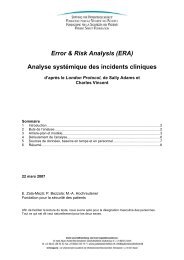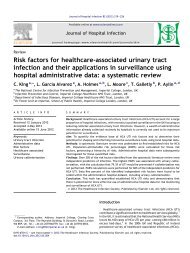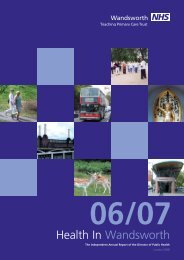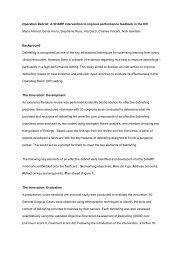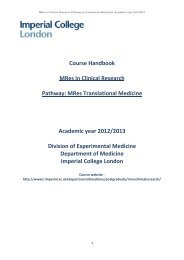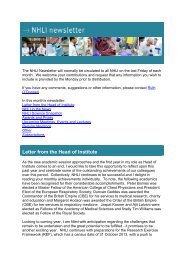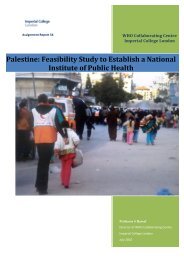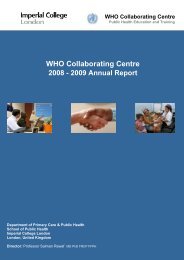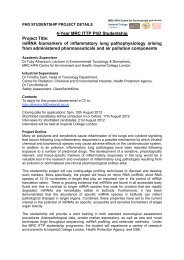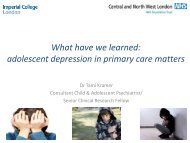QOF Plus Year 1 - Imperial College London
QOF Plus Year 1 - Imperial College London
QOF Plus Year 1 - Imperial College London
Create successful ePaper yourself
Turn your PDF publications into a flip-book with our unique Google optimized e-Paper software.
Priority and relevance to national policyAddressing alcohol misuse is a key priority for the Government. The Government’s Alcohol HarmReduction Strategy for England was published in 2004. In 2007, the Government followed thiswith a new publication: ‘Safe. Sensible. Social. The Next Steps in the National Alcohol Strategy’.The Review of the Effectiveness of Treatment for Alcohol Problems published by the NationalTreatment Agency (Raistrick et al., 2006) provides a comprehensive review of the researchsurrounding identification and management of alcohol problems. In his final report of the NHSNext Stage Review (2008), Lord Darzi listed the reduction of alcohol harm as one of the key goalsfor primary care trusts to address when commissioning comprehensive well-being and preventionservices, in partnership with local authorities…” The Department of Health and GeneralPractitioner Committee (GPC) have very recently released details of a new Directed EnhancedService (DES) for Alcohol, incorporating screening and brief interventions.Prevalence of conditionIn 2004 an estimated 8.2 million people in England aged 16-64 (26 percent of the totalpopulation) had an alcohol use disorder in England. 38 percent of these were men and 16 percentwere women (Drummond et al., 2004).Associated morbidity and mortalityExcess alcohol consumption is responsible for significant amounts of morbidity and mortality andcosts the health service £1.7bn per annum (Hutchings et al., 2006). Alcohol misuse is associatedwith up to 22,000 premature deaths in England and Wales annually, and a significant proportionof these are due to alcohol-related liver disease (Prime Minister’s Strategy Unit, 2004). Alcoholmisuse is responsible for over 30,000 hospital admissions per year for alcohol dependencesyndrome, and up to 70% of all admissions to accident and emergency departments at peak times(Leon et al., 2006). Annually, alcohol misuse is associated with approximately 14 percent ofdeaths from injuries, which involves about 1700 individuals. Alcohol misuse may be linked to 38-45 percent of deaths in fires, 7-25 percent deaths at work and 23-38 percent of deaths fromdrowning (Leon et al., 2006). Alcohol misuse may be a causal factor in up to 41 percent ofsuicides. Of those presenting to hospital with self harm, 50 percent were found to be regulardrinkers and 23 percent were dependent (Leon et al., 2006). 1.2 million violent incidents (aroundhalf of all violent crimes), 360,000 incidents of domestic violence (around a third), increased antisocialbehaviour and fear of crime, up to 17 million lost working days, between 780,000 and 1.3million children affected by parental alcohol problems, and an increased divorce rate have beenattributed to alcohol use (Cabinet Office, 2004). Alcohol is responsible for 3.5 percent of deathsfrom cancer in the UK, or 5000 deaths per year (Prime Minister’s Strategy Unit, 2003). Alcoholmisuse is also a risk factor for cardiovascular disease (Royal <strong>College</strong> of Physicians, 2001).28



